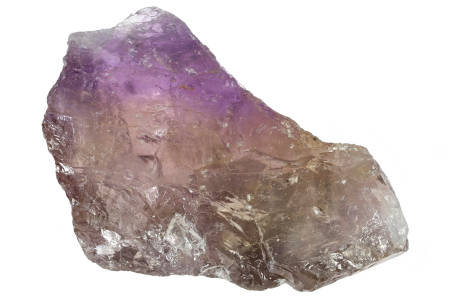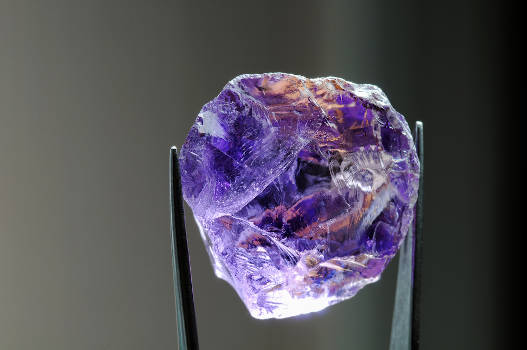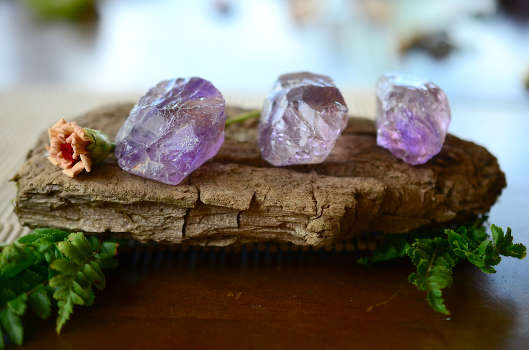Amethyst is beautiful, mysterious and wonderful for unlocking the secrets of the mind. Citrine is effervescent, bright, and one of the best stones for attracting prosperity and fostering optimism. Put them together, and what do you get? Ametrine!
This purple and yellow-to-orange stone is an intriguing blend of the look and energetic properties of both amethyst and citrine. Rare and difficult to find in nature, it’s a specimen well worth hunting for.
About Ametrine
Ametrine is literally what it says on the tin. It’s a crystal that, due to varying conditions within the earth, shows as both amethyst and citrine in a single stone.
Both the purple of amethyst and the yellow of citrine in these stones are largely due to iron ions. In amethyst, they’re unoxidized, while in citrine, they are.
When a single amethyst is subjected to a temperature gradient, some areas will oxidize to citrine. This creates interesting color zones within the crystal that range from light lilac or deep purple, to yellow or orange.

While commonly sold as ametrine, it may also be called trystine, or bolivianite. The name bolivianite comes from the fact that almost all ametrine on the market is mined in Bolivia.
Like other varieties of quartz, ametrine has a Mohs scale hardness of 7.
Ametrine Healing Properties & Benefits
Ametrine is a helpful stone for sexuality, and for people who’ve experienced gender-based trauma.
It combines the active, projective characteristics of citrine, and the passive, receptive characteristics in amethyst in a single stone, reflecting the balance of masculine and feminine energies in every person.
It’s also useful for balancing in a general sense. For people who tend to exhibit more Fire energy, for example, it can help bring the other elements into proportion. This crystal is alleged to be particularly helpful for depression and stress.
Physically, it’s considered useful by crystal healers for resolving chronic conditions. It’s also said to detoxify and renew the body, correct metabolic issues, and aid with conditions that are caused or worsened by stress. Ametrine also removes energetic blocks.
Ametrine Magical Properties
As a stone of the New World, ametrine didn’t enter the worldwide sphere until the 1600s. This means that it wasn’t widely available for witches and other practitioners of folk magic.
Today, it’s more common. As a result, modern magic practitioners use it for a variety of purposes in rituals, spells, and meditations.
This stone is often used to enhance spiritual growth and perception. Citrine is a cleansing stone, while amethyst is frequently employed to enhance intuition and psychic abilities. As ametrine, they clear unwanted energies and improve the “second sight.”
Due to its citrine content, ametrine is used to enhance creativity. Acting with amethyst, this creativity typically shows up as inspiration from dreams and visions.
As a balancing stone, ametrine is useful for reconciling the spiritual and physical realms. It can help people who begin to suffer from escapism, withdrawing from the physical reality in order to spend time within an inner world.

This crystal can also act as a protector, particularly during astral travel. It’s a very good protective charm for those who have come under psychic attack.
In color magic, ametrine combines the properties of purple and yellow. Purple governs psychic matters, success, meditation, and power. Yellow is learning, intellect, creativity, and action.
For those who work with chakras, ametrine is a bit complex. The citrine component resonates with the solar plexus chakra, the seat of confidence and will. The amethyst component resonates with the crown chakra, the one that connects humans to spirit.
This means that it’s useful for combining will and the desire and ability to act with spirituality. It helps create a strong attunement with higher intelligence and the spirit world, while also providing a focus for the user’s personal power.
How to Cleanse Ametrine
As a type of quartz, ametrine can handle a lot of cleansing methods. You may choose whichever one resonates the most strongly with you and your individual stone.
Some methods for cleansing Ametrine include:
- Holding it in fresh, running water. Ideally, this should be from a natural source — a stream, river, ocean, or rain.
- Bathing it in an infusion of cleansing herbs. Brew the infusion the way you’d make tea, allow it to cool, strain out the herbs, and use the liquid.
- Setting it in the sunlight for a few minutes.
- Setting it in moonlight. Do this right after sunset, and remove the stones before sunrise.
- Placing the crystal with other crystals, like clear quartz or selenite.
- Placing it in a dish of sea salt.
- Sprinkling it with cleansing herbs.
- Playing songs, chimes, instruments, bells, or singing bowls. If you use a singing bowl, don’t place the stone directly in the bowl itself. It may shatter.
- Using your personal energy.
- Burying the stone in soil. You can use a potted plant for this, or a well-marked area outdoors. For best results, bury the stone in a shallow basket so you can find it easily again.
It should be noted that ametrine’s color may be altered by bright sunlight, so it’s best to limit exposure to no more than a few minutes of filtered light.
Getting Started With Ametrine
Ametrine isn’t an extremely rare stone, but natural specimens can be difficult to find. All natural ametrine comes from Bolivia, so be sure to verify that your metaphysical or crystal shop sources their stones from ethical mining operations.
If they’re unable or unwilling to stand behind their suppliers, seek out a different shop.
Ametrine is often faked. This can be achieved in a similar way as imitation citrine — by exposing amethyst to heat.
If only a portion of the crystal is heated, it will resemble natural ametrine. There’s no real, easy way to tell the difference between heated amethyst and natural ametrine.
Some specimens might be colored glass. Ametrine stones that are suspiciously cheap, softer than quartz, and contain small bubbles are likely to be glass rather than genuine crystal.

The best way to choose a crystal is to allow it to choose you. Start with one that you connect with visually — one that looks pretty to you.
Pick it up with your non-dominant hand, and see how its energy feels. If you can’t feel crystal energy, don’t worry. As long as you don’t suddenly feel angry, sad, dizzy, or other unpleasant emotions or sensations, you’ve chosen a good crystal for you.
Once you have it at home, you should cleanse it. Crystals endure a lot once they’re taken from the Earth, and their journeys can impact their energy. Cleansing helps return them to their natural, resting state, which prepares them for important healing or magical work.
After cleansing, your ametrine is ready for use. You can use it to make a gem elixir, meditate with it, incorporate it into your yoga or exercise practice, or treat it as a magical tool.
If your ametrine is set in jewelry, be sure to program it before you start wearing it regularly — this aligns its energy with your desires.
To do so, hold the stone in your dominant hand. Visualize your desired outcome as if it has already been achieved. As you do this, send your energy into the stone. When you feel a pushback, as if the crystal can’t hold anymore energy, it’s ready.
Ametrines are unique stones that manage to hold a surprising amount of conflicting energies within them. They express the conscious and subconscious, active and passive, and all of the polar opposites of crystal energy.
Working with them is a privilege, and they should be treated like the valuable magical and healing tools that they are.
